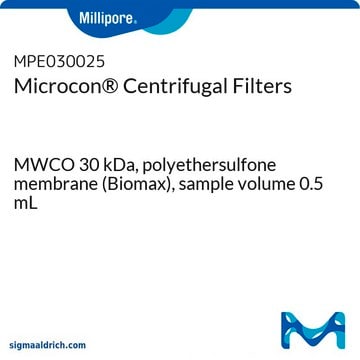MRCF0R030
Microcon® Zentrifugenfilter
NMWCO 30 kDa, Ultracel® regenerated cellulose membrane (low binding), sample volume 0.5 mL
Synonym(e):
Centrifuge concentrator
About This Item
Empfohlene Produkte
Materialien
Ultracel® regenerated cellulose membrane (low binding)
polyacetal base (membrane support)
polycarbonate device top
polypropylene tube (for filtrate/concentrate)
silicone O-ring (medical-grade)
Qualitätsniveau
Sterilität
non-sterile
Leistungsmerkmale
holdup volume> 10 μL
Hersteller/Markenname
Microcon®
Parameter
0.5 mL sample volume
Methode(n)
DNA purification: suitable
RNA purification: suitable
protein extraction: suitable
protein purification: suitable
Länge
4.50 cm (1.8 in.)
Durchmesser
12.3 mm
Filtrationsfläche
0.32 cm2
Porengröße
30 kDa NMWCO
Versandbedingung
ambient
Verwandte Kategorien
Allgemeine Beschreibung
•Typische Rückgewinnungsraten von über 95 %, selbst bei verdünnten Lösungen
•Maximale Rückgewinnung durch umgekehrte Zentrifugation, selbst bei den kleinsten Proben
•Praktische Aufbewahrung des Filtrats oder der konzentrierten Probe in Standard-Mikrozentrifugenröhrchen
•Konzentrierungsfaktoren bis zu 100X
Merkmale:
•Hohe Rückgewinnungsraten bei kleinen Probenvolumina durch umgekehrte Zentrifugation (Konzentrierungsfaktor weniger als 20X)
•Geringbindende Ultracel Membran
•Schnelle Verarbeitung
Beispielanwendungen:
•Rückgewinnung genomischer DNA für forensische Anwendungen
•Konzentrierung und Entsalzung von Nukleinsäuren (Alternative mit hoher Rückgewinnung zu Ethanolpräzipitation)
•Entfernung von Primern aus amplifizierter DNA
•Einfache Filtratrückgewinnung dank des flachen Membrandesigns
Verlinkung
Rechtliche Hinweise
Lagerklassenschlüssel
10-13 - German Storage Class 10 to 13
Analysenzertifikate (COA)
Suchen Sie nach Analysenzertifikate (COA), indem Sie die Lot-/Chargennummer des Produkts eingeben. Lot- und Chargennummern sind auf dem Produktetikett hinter den Wörtern ‘Lot’ oder ‘Batch’ (Lot oder Charge) zu finden.
Besitzen Sie dieses Produkt bereits?
In der Dokumentenbibliothek finden Sie die Dokumentation zu den Produkten, die Sie kürzlich erworben haben.
Artikel
An optimized peptide mapping protocol using NISTmAb as a model monoclonal antibody, shorter incubation times, and improved digestion buffer to demonstrate minimal artificial asparagine deamidation and methionine oxidation.
Rapid trypsin digest kit yields reliable results in less than 2 hours for mass spectrometry analysis.
PNGase Fast denaturing buffer and enzyme provide results similar to a conventional 20-hour protocol, reducing workflow time to about 1 hour.
Method development for protein fingerprinting of AAV serotype 5 using both intact mass analysis and peptide mapping, to determine critical quality attributes for gene therapy, utilizing three different columns.
Protokolle
An optimized LC-MS/MS based workflow for low artifact tryptic digestion and peptide mapping of monoclonal antibody, adalimumab (Humira) using filter assisted sample preparation (FASP).
A step-by-step protocol for released N-linked glycan analysis of the monoclonal antibody adalimumab, based on UHPLC-FLR-MS and procainamide labeling.
Verwandter Inhalt
Microcon® Centrifugal Filters simply and efficiently concentrate and desalt solutions of DNA, RNA, protein or other macromolecules, using any centrifuge that can accept 1.5 mL tubes.
Unser Team von Wissenschaftlern verfügt über Erfahrung in allen Forschungsbereichen einschließlich Life Science, Materialwissenschaften, chemischer Synthese, Chromatographie, Analytik und vielen mehr..
Setzen Sie sich mit dem technischen Dienst in Verbindung.


